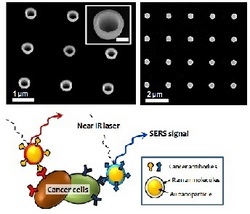Tadaaki Nagao at the International Center for Materials Nanoarchitectonics (MANA), National Institute for Materials Science (NIMS) and colleagues in Germany and Spain present a review on plasmons in metallic nanomaterials.
The article is published this week in the journal Science and Technology of Advanced Materials.
 SEM images of nanoparticles fabricated for SERS by electron-beam
lithography (above). Illustration of multiplex cancer targeting by SERS nanoparticles encoded by Raman molecules and cancer antibodies (below).
SEM images of nanoparticles fabricated for SERS by electron-beam
lithography (above). Illustration of multiplex cancer targeting by SERS nanoparticles encoded by Raman molecules and cancer antibodies (below).
The authors provide an extensive overview of the properties of plasmons in nanomaterials with emphasis on pioneering work of Ruthemann and Lang on electron energy loss spectroscopy (EELS) of electron motion in thin metal foils; recent infrared analysis of nanoscale metallic nanorods and nanoislands produced by ‘top-down’ photolithography; and the potential of metallic atomic wires for supporting plasmonic resonating modes. The review includes detailed explanations of plasmons for in vivo biosensing and nanoantennas.
A plasmon can be visualized as a collective oscillation of electronic ‘liquid’ in metals, similar to waves in lake, which are collective mode of the water molecules. Furthermore, surface plasmons are such oscillations confined to the surfaces of metals, which display a strong interaction with light, leading to the formation of so-called ‘polaritons’. Futuristic applications of plasmons include ideal lenses and even invisibility cloaks.
Research in the 1940s by Ruthemann and Lang on electrons flowing in thin metal foils using EELS yielded the first experimental sign of the presence of the theoretically predicted ‘plasma oscillations’ in metals. In 1957 Richie and colleagues predicted the existence of ‘surface localized’ plasmons, which was confirmed by Powell and Swan by EELS a few years later. In the 1960s researchers determined optical dispersion curves using optical spectroscopy, thereby opening up the possibility of optical applications of plasmon structures.
In this review, Nagao and colleagues offer insights into optical applications of localized surface plasmons in structures produced by photolithography. Specific examples include metallic nanoantenna detectors—where resonant excitation of light leads to ultrahigh electromagnetic field enhancement owing to plasmon polaritons localized at the surface of nanostructures; and optical interactions between arrays of nanorods for ‘surface enhanced Raman scattering’, which shows potential for in vivo biomolecular sensing. The authors also describe the fabrication of a prototype random-nanogap antenna for enhanced IR spectroscopy and in situ spectral monitoring of surface enhancement of infrared absorption during film growth.
Furthermore, the authors describe new trends in plasmonics research, in particular observation of plasmonic resonant modes in indium nanowires grown in ultrahigh vacuum on stepped silicon substrates. They predict that these nanowires will be used as building blocks for developing plasmonic devices of the future.
This review includes 86 references and 12 figures, providing an invaluable source of up-to-date information for newcomers and experts in this exciting field of research.
Source: http://www.nims.go.jp/